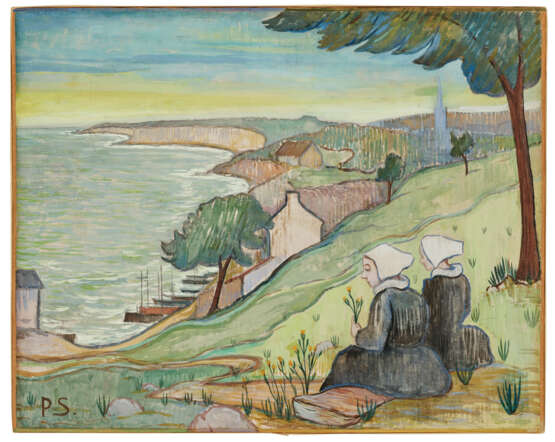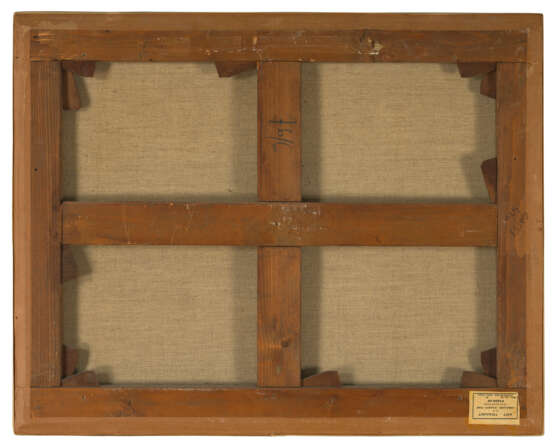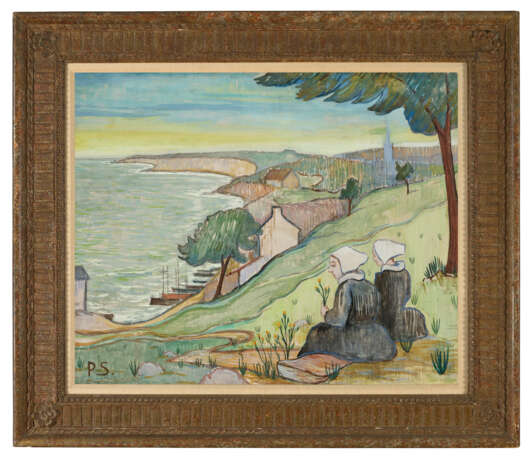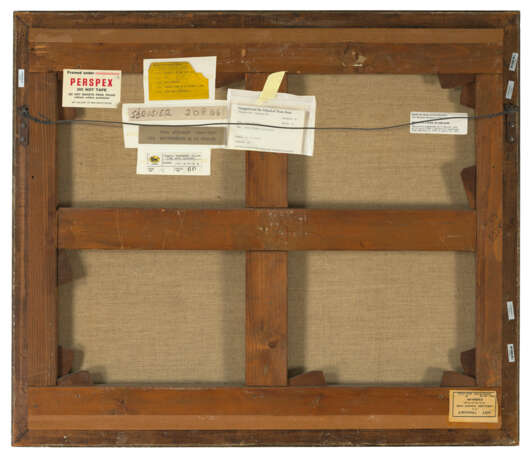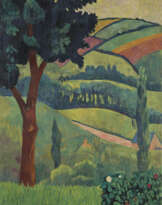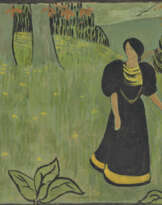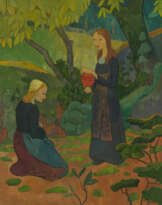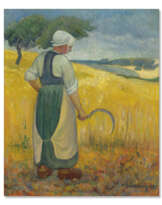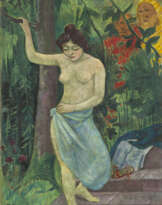ID 1051792
Lot 408 | Paul Sérusier (1863-1927)
Estimate value
€ 220 000 – 280 000
Bretonnes au Pouldu
signé des initiales 'PS.' (en bas à gauche)
peinture à l'œuf sur toile
58.3 x 73.2 cm.
Peint en 1892
signed with the initials 'PS.' (lower left)
tempera on canvas
23 x 28 7⁄8 in.
Painted in 1892
Provenance
Vente, Me Blache, Versailles, 19 mai 1959.
Sam Josefowitz, Pully (avant 1960).
Puis par descendance aux propriétaires actuels.
Literature
C. Chassé, Les Nabis et leur temps, Lausanne et Paris, 1960, p. 182, no. 19 (illustré, pl. 19; daté '1894').
A. Ellridge, Gauguin et les Nabis, Paris, 2001, p. 67 (illustré en couleurs).
Exhibited
Londres, The Tate Gallery, Gauguin and the Pont-Aven group, janvier-février 1966, p. 40, no. 201 (illustré, pl. 28f).
Tokyo, The Bunkamura Museum of Art; Kyoto, The National Museum of Modern Art; Hokkaido, Hokkaido Museum of Modern Art; Mie, Mie Prefectural Art Museum et Koriyama, Koriyama City Museum of Art, Gauguin et l'École de Pont-Aven, avril-novembre 1993, p. 79, no. 60 (illustré en couleurs; daté 'vers 1893').
Sydney, The Art Gallery of New South Wales, Gauguin and the Pont-Aven School, mai-juillet 1994, p. 186 et 222, no. 115 (illustré en couleurs, p. 187; daté 'vers 1893').
Indianapolis, Indianapolis Museum of Art; Baltimore, The Walters Art Gallery; Montréal, The Montreal Museum of Fine Arts; Memphis, The Dixon Gallery and Gardens; San Diego, San Diego Museum of Art; Portland, Portland Art Museum; Boston, Museum of Fine Arts et Jérusalem, The Israel Museum, Gauguin and the School of Pont-Aven, septembre 1994-janvier 1997, p. 147, no. 115 (illustré en couleurs; daté ‘vers 1893’).
(prêt) Toronto, Art Gallery of Ontario (depuis 2018).
Further details
Captivés par la simplicité et la beauté rustique de cette région, les représentations de Sérusier de la population locale restent parmi ses œuvres les plus importantes de l’artiste, comme en témoignes les présentes Bretonnes au Pouldu. Isolées à l'extrême ouest du continent européen, les petits bourgs bretons de Pont-Aven et du Pouldu ont été pratiquement épargnées par les effets de l'industrialisation galopante que connaissent alors de nombreuses villes françaises au début du XIXe siècle. Ces petites villes, qui se distinguent par la culture et les traditions de leurs habitants, leur mode de vie intemporel et la nature brute de leur paysage, offrent un contraste saisissant avec la capitale française. La richesse visuelle des paysages intacts et les activités quotidiennes des paysans locaux devirent rapidement une source d’inspiration intarissable pour Sérusier mais aussi Gauguin (que Sérusier rencontre pour la première fois en 1888) et les autres peintres de l’école de Pont-Aven.
Peinte en 1892, la présente toile, très construite, témoigne de l’influence de Gauguin et des estampes japonaises sur l’art de Paul Sérusier. Les deux femmes au premier plan, habillées de leur robes et coiffes traditionnelles, font face à une vue plongeante sur la mer, typique de ses paysages bretons. Ce paysage dynamique capture le caractère accidenté des paysages du Pouldu et de ses alentours. Cependant, un sentiment de tranquillité et de calme se dégage de ce tableau, caractéristique de l’œuvre de Sérusier, lui qui était fasciné par la beauté rustique et la simplicité de la vie en Bretagne.
Captivated by the simplicity and rustic beauty of this region, Sérusier’s depictions of the local population remain among his most important works, as illustrated by the present Bretonnes au Pouldu. I solated in the far west of the European continent, the small Breton towns of Pont-Aven and Le Pouldu were virtually untouched by the effects of the rampant industrialisation that swept through many French towns in the early 19th century. These small towns, characterised by culture and traditions of their inhabitants, their timeless way of life and the raw nature of their landscape, offer a striking contrast to the French capital. The visual richness of the unspoilt landscapes and the daily activities of the local peasants soon became an inexhaustible source of inspiration for Sérusier, but also for Gauguin (whom Sérusier met for the first time in 1888) and the other painters of the Pont-Aven school.
Painted in 1892, this carefully structured painting bears witness to the influence of Gauguin and Japanese prints on Paul Sérusier's art. The two women in the foreground, wearing their traditional dresses and headdresses, stare out onto a plunging view of the sea, typical of his Breton landscapes. This dynamic landscape captures the rugged character of the landscape in and around Le Pouldu. At the same time, there is a sense of tranquillity and calm in this painting, typical of Sérusier's work, who was fascinated by the rustic beauty and simplicity of life in Brittany.
| Artist: | Paul Sérusier (1864 - 1927) |
|---|---|
| Applied technique: | Oil on canvas |
| Auction house category: | Paintings |
| Artist: | Paul Sérusier (1864 - 1927) |
|---|---|
| Applied technique: | Oil on canvas |
| Auction house category: | Paintings |
| Address of auction |
CHRISTIE'S 9 Avenue Matignon 75008 Paris France | ||||||||||||||
|---|---|---|---|---|---|---|---|---|---|---|---|---|---|---|---|
| Preview |
| ||||||||||||||
| Phone | +33 (0)1 40 76 85 85 | ||||||||||||||
| Fax | +33 (0)1 40 76 85 86 | ||||||||||||||
| Conditions of purchase | Conditions of purchase | ||||||||||||||
| Shipping |
Postal service Courier service pickup by yourself | ||||||||||||||
| Payment methods |
Wire Transfer | ||||||||||||||
| Business hours | Business hours
|

